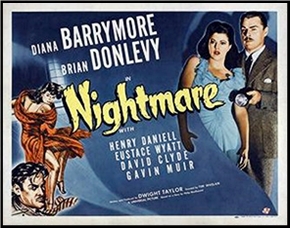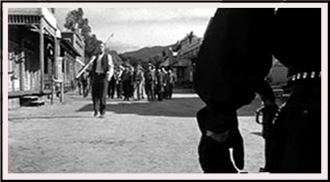June 2022
Monthly Archive
Thu 30 Jun 2022
KENNETH BULMER – Cycle of Nemesis. Ace G-680, paperback original, 1967. Cover art: Kelly Freas.
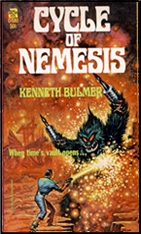
After 7000 years, Khamushki the Undying is able to break the seven locks on the Time Vault in which has been imprisoned. The compete destruction of Earth for the second time is threatened, and it is up to our group pf five (plus one robot named Charlie) to prevent it. K the U has control over both time and space but the weakening of his guardians aid in his defeat for another 7000 years.
The terror of mythology comes to life as science. Ridiculous. About as bad as a Fantastic Adventures story from the thirties. Even Bulmer cannot adequately motivate the continuity of he project, though he tries hard, every two or three pages. Probably too hard. Acceptance [of the basic story line] might otherwise come easier. Most people [caught up in a situation such as this] would become quietly drunk if not insane.
The beginning is promising, at least, but by halfway through, reading is a struggle.
Rating: *½
– January 1968
Tue 28 Jun 2022
A 1001 MIDNIGHTS Review
by Marcia Muller
KENN DAVIS – Words Can Kill. Carver Bascombe #5. Fawcett Gold Medal, paperback original, 1984.
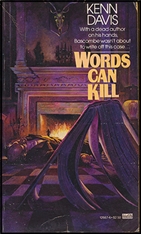
Black San Francisco private eye Carver Bascombe just can’t seem to decide what he wants to be when he grows up. On the one hand, he’s merely doing detective work for the money, to get through law school and “be able to help others.” On the other hand, he enjoys “the hunt.” It’s “something he can sink his teeth into,” a deeply ingrained part of him since he was a kid in the ghetto of Detroit.
So Carver carries on as a private eye, worrying about his overdue tuition and term papers — even worrying about completing his income-tax forms, for heaven’s sake. And because he’s a part-timer, a man sitting on the fence, he’s not all that effective at his work.
In this case, Carver receives a visit from old Vietnam buddy Jackson Fayette. Fayette is now the author of the “definitive;’ Vietnam novel, a celebrity very much. in the public eye. Fayette’s mentor, Ed Colfax, was shot to death in nearby Sausalito the previous night; he wants Carver to find out why; Carver plunges into the world of Marin County writers and rare-book collecting (the latter described with dubious accuracy; one would never, for instance, display copies of rare books in a store window, where their dust jackets would fade).
On the dead man’s houseboat, he discovers a manuscript that indicates Colfax may have coauthored Fayette’s book but received no credit for his part. Carver meets other writers, friends of Colfax’s. He goes to a party, gets drunk, blurts out too much information about what he is investigating, and then almost loses his life in a fire on Colfax’s houseboat. And he continues on his way, always worrying: When will he complete his overdue term paper? Does he even want to? What about his taxes? What’s going on anyway?
Well, what’s going on becomes pretty obvious to the reader, long before it becomes obvious to Carver. Still and all, there’s something appealing about Carver Bascombe; something that makes this reviewer want to read more of these novels and perhaps find out the answer to that all important question: What will Carver decide to be when he grows up?
Among Davis’s other Carver Bascombe novels are The Dark Side (1976, in collaboration with John Stanley) and The Forza Trap (1979).
———
Reprinted with permission from 1001 Midnights, edited by Bill Pronzini & Marcia Muller and published by The Battered Silicon Dispatch Box, 2007. Copyright © 1986, 2007 by the Pronzini-Muller Family Trust.
Mon 27 Jun 2022
Posted by Steve under
Reviews[6] Comments
REVIEWED BY JIM McCAHERY:
DAVID ALEXANDER – Paint the Town Black. Bart Hardin #2. Random House, hardcover, 1954. Bantam #1534, paperback, 1956.
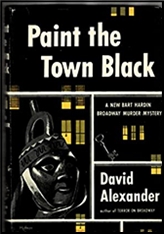
In this second adventure of Bart Hardin, managing editor of the Broadway Times, a missing pre-Columbian portrait jar (and a known fake, at that) stirs as much interest as the Maltese Falcon. The jar is actually a burial artifact sculpted to resemble the dead warrior with whom it was to be buried.
It appears as the center of attraction upon its disappearance shortly after Bart gets a needed part-time job as publicist for Latin American Trade Alliance,Ltd., importers of pre-Columbian art and supposed front for a South American union of nations for peace.
The first victim in Bart’s own well-known apartment is his wartime buddy and now T.V. “crime stopper,” Mike Ainslie, whose wife Dorothy has long been Bart’s ideal woman from afar. Bart and other friends mourn Ainslie’s death as the title suggests, but Bart soon sees red when his near blind bulldog Old Bones is senselessly beaten to death in the apartment as well.
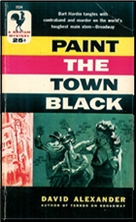
The fast-paced plot takes Bart to New Jersey and to various areas of Manhattan which are mourned in turn as they sadly reflect the changing times. The Town once again becomes a main character, and lovers of New York will find it easy to relate to and empathize with Alexander’s narrative.
All the series regulars come to the fore at one point or another — Lt. Romano, Detective Grierson, the Irish bartender Maclaren, Old Top Sarge, turf editor Popa Taylor, down-and-out old actor James Lennox, loan shark Moe Selig, and Bart’s landlord Bromberg who runs the Fun Arcade and Flea Circus below his apartment.
Add some highly unlikable adversaries including a chinless psycho named Teeth with a love of sadism and you can be sure that the action will be nonstop. You will probably spot the whereabouts and importance of the jar early, but the two-way chase retains its tension as Hardin hunts down the hunters.
– Reprinted from The Poison Pen, Volume 2, Number 5 (Sept-Oct 1979).
Sun 26 Jun 2022
Posted by Steve under
Reviews[10] Comments
MIKE ROSCOE – One Tear for My Grave. Johnny April #4. Crown, hardcover, 1955. Signet #1358, paperback, 1956.
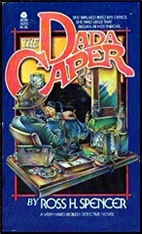
If you’re a hard-boiled detective fan, you’ve surely already seen the recently released take-off of the form perpetrated by Ross H. Spencer in The Dada Caper (Avon, 1978), the first recorded case of one Chance Purdue, and written entir6ly 1n the punchy style of one-sentence paragraphs.
It’s very effectively done, and the temptation is overwhelming to open it at random and start reading aloud to whoever happens to be so unfortunate as to be in the same with you at the time. Take p. 126, for example:
Two shadowy figures came at me out of the darkness.
I didn’t hesitate.
I hit the first shadowy figure right between the eyes.
I stepped over him.
I hit the second shadowy figure right between the eyes.
I stepped over him.
I looked for the scrawny guy.
I wanted to hit him right between the eyes.
The scrawny guy wasn’t there.
He was out on California Avenue.
He was hollering help police and any number of ridiculous things.
Notice how the last line sort of blunts the rhythm.
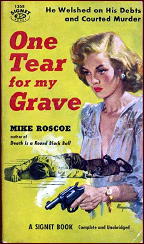
This happens to be a review of another private eye story, however [the one by Mike Roscoe], and one written much earlier, and to satisfy equal time requirements, try this from p. 67:
The boys began backing out. I moved forward, inch by inch, half pushing, half-carrying my load.
Then we were out in the other room.
I stopped. “I’m tired of hauling this lard-ass around. Out you go or I blow his head off.”
I turned my glance to the gun. Their eyes followed. I began to squeeze the trigger.
Christ, I almost had to shoot the guy.
Then Tommy hollered.
Okay, you win again. Come’n. He nudged the other boy.
The door closed behind them.
I removed the gun from his throat, then pushed with all I had, at the same time giving his neck a half twist. He spun away from me and fell to the rug.
Allow for a bit of exaggeration and a not-so-subtle counterbeat of ridicule. The tough private eye yarn is a pretty clearly an easy target.
Johnny April is the name of Roscoe’s detective, and the scene Kansas City. This particular case begins with a gambling deadbeat who’s found murdered and continues with a subsequent sequence of dead bookies. Gamblers and high society prove to be a volatile mixture.
The short staccato sentences do keep things cool and crisp, but maybe you’ve never heard of Mike Roscoe. That’s because style is hardly ever a satisfactory substitute for content. What you end up reading this for is for whatever pleasure is obtained from the individual ingredients, not for any great desire to see how it all comes out.
Overcooked.
Rating: C
– Slightly revised from The MYSTERY FANcier, September/October 1978.
The Johnny April series —
Death Is a Round Black Ball. Crown 1952.
Riddle Me This. Crown 1952.
Slice of Hell. Crown 1954.
One Tear for My Grave. Crown 1955.
The Midnight Eye. Ace 1958
Sat 25 Jun 2022
Posted by Steve under
Reviews[2] Comments
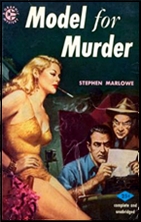
STEPHEN MARLOWE – Model for Murder. Graphic #94, paperback original; 1st printing, 1955. Berkley D2023, paperback, date? Armchair Fiction, paperback, 2014. Wildside Press, trade paperback, 2015.
While Graphic was a relatively minor player in the mix of paperback publishers that sprung forth in the 1950s, especially when it came to semi-hardboiled mysteries, every once in a while one can catch your eye more than the others. Such a one is Model for Murder.
It begins with the book’s main protagonist being released and hooking up with an old friend (female) on his first night (and overnight) on the outside. It gets complicated from here. Chase was innocent of the charges (financial finagling) that sent him up. He took the rap for his well-heeled brother, who sends him a check for $100,000 for services rendered. While he was in stir, though, the brother married the woman Chase was in love with.

And in the same meantime the previously mentioned lady friend Chase quickly catches up with has a problem. She works for a professor who has compiled data (voluntary but coded) on the elite of Manhattan that was “out Kinseys Kinseyâ€), and for a lark, she has stolen it. Paying for the crime is her roommate, whom she and Chase find dead and the data missing. Presumably it is now in the hands of someone with blackmail on his mind.
Meanwhile Chase’s brother is also in blackmail trouble, this time in the form of his wife (who was the love of Chase’s life before he went up the river). Coincidence? Well, maybe, but you probably know how things like this go in book like this.
Or, in other words, there is a lot of plot crammed into the 190 pages of Model for Murder, and while Stephen Marlowe (born Milton Lesser) was just starting out as mystery writer – as Lesser he was no more than a prolific writer of mostly mediocre science fiction – every so often he has a turn of phrase that a certain Mr. Chandler might have been proud of. And as far as plot goes, this barely scratches the surface. Sleazy photos, dysfunctional families, hired goons, a veritable Amazon of a bodyguard, more bodies, and a slick private eye — you name it.
And in case you don’t know, Stephen Marlowe – and you needn’t wonder how he chose that name – went on to have a decent career writing the PI/secret agent Chester Drum series for Gold Medal, as well as some even more serious fiction later on.
Fri 24 Jun 2022
REVIEWED BY DAN STUMPF:
NIGHTMARE. Universal, 1942. Diana Barrymore, Brian Donlevy, Henry Daniell, Arthur Shields, Gavin Muir, Ian Wolfe, Hans Conried, and John Abbott. Screenplay by Dwight Taylor, from a story by Philip MacDonald. Directed by Tim Whelan. Currently available here on YouTube.
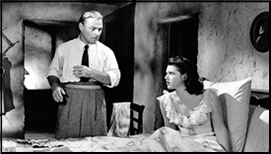
A fast-moving “B+†from Universal.
Brian Donlevy headlines as an American in London who finds himself blitzed out of his gambling club (This is 1942, remember.) leaving him homeless and penniless, with nothing but the tuxedo he stands in. In a fit of casual desperation, he breaks into an empty-looking town house, only to find it occupied by Diana Barrymore, and, to a lesser extent, by her estranged husband Henry Daniell, who sits slumped over his desk with a knife in his back.
Diana asks him to help dispose of the corpse and he agrees, which leads to a whole mess of complications involving the Police, Nazi Saboteurs, attack dogs, and Ms Barrymore, who may not be what she seems.
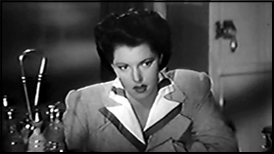
This was made concurrently with Universal’s updated Sherlock Holmes series (It was released two months after Voice of Terror) and shares some of the regular players, sets, and background music, albeit in service of a higher budget. Henry Daniell, then a contract player at Universal, doesn’t get much to do, playing a corpse except for a short flashback, but Hans Conried makes the most of a nearly wordless bit part as a Nazi Goon.
Overall, Nightmare is nothing really special, but Director Whelan moves Dwight Taylor’s screenplay along with a snappy pace that makes up for the lack of any discernible style, and the players take it seriously even when the viewer (this viewer anyway) can’t.
Thu 23 Jun 2022
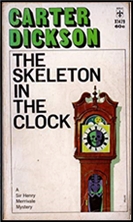
CARTER DICKSON – The Skeleton in the Clock. Sir Henry Merrivale #18. Morrow, hardcover, 1948. Dell #481, paperback, 1951. Berkley X1479, paperback, 1967. Belmont, paperback, 1973. Leisure, paperback, 1977. Bantam, paperback, 1982.
Three postcards send Sir Henry Merrivale off to Fleet House to solve a twenty year old mystery. When Martin Drake’s search for a girl met briefly during the war comes to an end, he discovers her already engaged, and his attempts to break up the marriage bring about the murderer’s wrath.
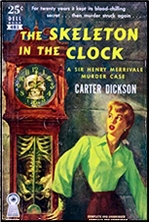
One night is spent in the condemned cell of local prison looking for ghosts, and a mutilated body is found the next morning. In addition, the final capture takes place in a house of mirrors belonging to a traveling fair, so there can be no complaints about adequate background.
However, there is a bit too many interrupted explanations (taken care of later after they are forgotten) and a bit too great a fatalistic attitude by some characters as they refuse to question unlikely business and to press unanswered questions. One obvious mistake (page 146 of the Berkley paperback) does not confuse anything, but the last 28 pages are needed to explain all.
The “locked room†is satisfactorily done, and is actually underplayed this time. As it turns out, the clock containing the skeleton might also be considered the family closet.
Rating: ***
– Dec 1967/ Jan 1968
Wed 22 Jun 2022
Posted by Steve under
Reviews[3] Comments
CLIFFORD RAYMOND – The Men on the Dead Man’s Chest. Bobbs-Merrill, hardcover, 1930.
Most mystery fans surely know what a tontine is by now, but if not, what it is is a special kind of annuity that provides for a certain regular amount to be shared among several beneficiaries over a period of time, but with the principal held in trust for the final survivor.
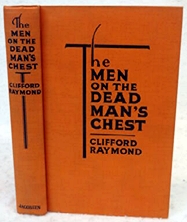
The implications are obvious, are they not? In fact, revenge can be made to reach from beyond the grave, as six former friends of an unsavory gentleman named Turner quickly discover.
According to Who Done It?, this was the last 1nystery novel that Clifford Raymond wrote. While he did write three earlier during the period 1917-21, the influence of the new Black Mask style on his later work is obvious. The Chicago police lieutenant named Stanton who investigates the curious string of deaths caused by Turner’s will is cool and crisp, and incisively sardonic without ever actually being hard-boiled. This is the Chicago of prohibition and Al Capone, and the reader is never allowed to forget it.
Numerous footnotes give an unusual air of documentary authenticity to the whole affair, but I have to confess that I didn’t understand the last one at all. The last page of a book is an awfully strange place to completely unexplain what until then had seemed a fairly straightforward tale of over-stimulated greed.
Nevertheless, the. combination of tough gangster fiction with a hint of underlying amusement makes the author’s final bow decidedly above average. The episode of the Vermont lawyer in itself makes this book worth hunting down. Why Raymond never wrote another mystery someone else will have to say.
Rating: B
– Slightly revised from The MYSTERY FANcier, September/October 1978.
UPDATE: The last line may not be entirely true. One additional title is now listed in Hubin with a dash, suggesting that it is marginally criminous, that being Our Very Best People (Bobbs-Merrill, 1931).
Tue 21 Jun 2022
REVIEWED BY DAN STUMPF:
TERROR IN A TEXAS TOWN. United Artists, 1958. Sterling Hayden, Sebastian Cabot, Carol Kelly, Eugene Martin, Ned Young. Screenplay: Dalton Trumbo (fronted by Ben L. Perry). Director: Joseph H. Lewis.
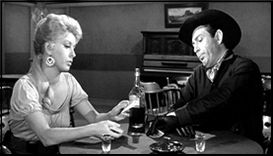
I watched Lewis’s Terror in a Texas Town again the other day, a film I have reviewed before. It’s a splendidly cheap thing, with Sterling Hayden as a Swedish whaler coming to help out his Dad on the besieged Ranch they bought, Sebastian Cabot as the dress heavy, and blacklisted Ned Young as the Ultimate Hired Gun, who looks like they coined the term”walking dead” just for him: He’s overweight, over-age, over-indulged, and with every gesture he conveys the feel of a deadly working stiff who long ago forgot what he’s doing all this for.
Lots of fine camera work, surprising characterization, and a few scenes that stay in the mind a long time, such as Young begging Hayden to take a few Steps closer so their final gunfight will be fairer — to Hayden.
— Reprinted from A Shropshire Sleuth #76, March 1996.
Mon 20 Jun 2022
REVIEWED BY BARRY GARDNER:
PETER BOWEN – Wolf, No Wolf. Gabriel Du Pré #3. St. Martin’s, hardcover, 1996; paperback, 1997.
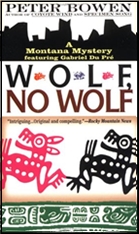
Bowen is also the author of the three-book Yellowstone Kelly series. Du Pré is a MetÃs breed, a descendant of the voyageurs, who works as a cattle inspector in Montana and lives with an Indian woman.
Trouble has come to Gabriel Du Pré’s Montana, trouble in the form of eco-terrorists who want the cattle lands taken away from the ranchers, and wolves reintroduced to the country. When two of the terrorists are shot after cutting fences and killing cattle, the FBI is called in, and a tense situation gets tenser in a hurry.
There are more killings, and Gabriel knows that the killers are almost certainly among his friends or acquaintances. And then the worst blizzard in memory sets in over the countryside, and survival becomes even more of a problem.
This is the second book I read within a week that has the Western cattlegrower’s/bunny-hugger’s conflict as a plot hook. It’s a complex and emotionally charged issue, and I don’t believe you can read this without giving it some serious thought.
I like this series a lot, but not for reasons that would necessarily translate into liking by anyone else. Bowen isn’t a tight, meticulous plotter, nor are his characters always strictly believable, nor will his idiosyncratic prose be to everyone’s taste. It’s to mine, however, and I like his sometimes larger-than-life characters, and I like his depiction of the people and culture of Montana cattle country.
I could do with a little less of his Indian mystic, but that’s my only real cavil. I can’t see anyone being neutral about these; you’ll either like them considerably, as I do, or you won’t care for them at all.
— Reprinted from Ah Sweet Mysteries #24, March 1996.
The Gabriel Du Pré series —
1. Coyote Wind (1994)
2. Specimen Song (1995)
3. Wolf, No Wolf (1996)
4. Notches (1997)
5. Thunder Horse (1998)
6. Long Son (1999)
7. The Stick Game (2000)
8. Cruzatte and Maria (2001)
9. Ash Child (2002)
10. Badlands (2003)
11. The Tumbler (2004)
12. Stewball (2005)
13. Nails (2006)
14. Bitter Creek (2015)
15. Solus (2018)
Next Page »










